9 Best Fuji Lens for Travel [2024] – Fujifilm Lenses Review

Are looking for the best Fuji lens for travel? As someone who shoots all their photos with Fujifilm, I can help!
So, you have the new Fujifilm X-T5 camera, but the kit lens isn’t quite cutting it? Want to dive into the world of travel photography, but you know your current setup won’t be quite right for the job?

Well, let me help you find the best Fujifilm lens for travel for you as a Fuji enthusiast (aka Fuji fangirl). I’ve owned and shot with the Fuji X-series system exclusively for the last 6 years for my travel blog and clients.
I started with the Fuji X-T2 before upgrading to the Fujifilm X-T4 camera.
I’ve also dropped some major bank on Fuji lenses, starting from the humble kit lens (Fuji 18-55mm f/2.8-4 ) to the Bohek monster that is the Fuji 56mm f1.2 lens and knows that choosing the right lens for your travels can be an absolute nightmare.
The sheer number of options alone is overwhelming. And that’s without diving into the nitty-gritty specs and features of each one.
The Fujifilm XF 16-55mm F2.8 R LM WR is a high-quality, all-around lens for photographers. With its excellent image quality and focus performance and accuracy, it’s one of the best lenses for travel and it works well with any X-series camera body.
But having the right lens can make a world of difference to your travel photography. So the process of choosing one is an adventure that all travel photographers must embark on at some point in their lives.
The good news is I’ve created a detailed guide to the best Fujifilm X mount lenses for travel on the market for travellers.
I’ve taken various aspects into account and reviewed, in detail, the 9 best Fuji X lenses for travel photography.
Best Fuji Lenses for Travel – Comparison Table
Here’s a quick comparison of my top picks before I get into the full reviews. Remember that all the lenses on this list are the best Fuji lenses.
Meaning they’re intended for use with Fujifilm’s X Series cameras. These are the cameras I’ve owned and the lens I’ve used with this system.
| Image | Product | Features | Price |
|---|---|---|---|
Editor’s Choice  |
| Check Price Here | |
Best Landscape Lens  |
| Check Price Here | |
Most Versatile Lens  |
| Check Price Here | |
Best Kit Travel Lens  |
| Check Price Here | |
Best Street Lens  |
| Check Price Here | |
Great Everyday Use Lens  |
| Check Price Here | |
Great Street Lens  |
| Check Price | |
Best Portrait Lens  |
| Check Price Here | |
Best Architecture Lens  |
| Check Price Here |
Best Fuji Lens For Travel
When you’re packing for a trip, you want to make sure you have the best photography gear with you to capture all the memories you’ll be making.
So, if you’re a Fujifilm shooter, what are the best Fujifilm lenses for travel? Here’s a list of our top picks:
Fujifilm XF 16-55mm F2.8 R LM WR – Best All-round Travel Lens

- 24-84mm equivalent zoom range for versatility
- Bright f/2.8 maximum aperture for shooting in low light and controlling depth of field
- Weather resistant
- Excellent image quality with reduced distortion and improved sharpness
- Quiet autofocus performance for video
- Relatively large and heavy compared to other Fujifilm lenses in the same category
- More expensive option within Fujifilm’s lineup of lenses
My all-around top pick for the best Fujifilm travel lens is the Fujifilm XF 16-55mm F2.8 R LM WR. This is one of the best Fuji lenses (and the Best fuji XF travel lens); it is a versatile standard zoom lens designed for APS-C-format FUJIFILM X-Mount mirrorless cameras.
This also makes it, in my opinion, the best Fuji lens for hiking.
Offering a 24-84mm equivalent, wide-angle to the portrait-length range, capturing various subjects, from wide landscape shots to portraits.
This lens is characterised by its bright f/2.8 maximum aperture, which makes it adept in difficult lighting conditions and offers control over the depth of field.

The optical design of the Fujifilm XF 16-55mm F2.8 R LM WR lens comprises both aspherical and extra-low dispersion elements, which help to reduce distortion and colour fringing for improved sharpness and colour accuracy throughout the zoom range.
Nano-GI and HT-EBC coatings have also been applied to the lens elements to minimise surface reflections and prevent lens flare and ghosting.
The Fujifilm XF 16-55mm F2.8 R LM WR lens also features a weather-resistant design with 14 sealing points, enabling worry-free use in inclement weather conditions and freezing temperatures as low as 14°F.
Additionally, a Twin Linear Motor autofocus system delivers smooth, near-silent performance that is especially beneficial to video applications and when working in noise-sensitive areas.
This is one of the best Fujifilm lenses for travel and an excellent lens for hybrid shooters.
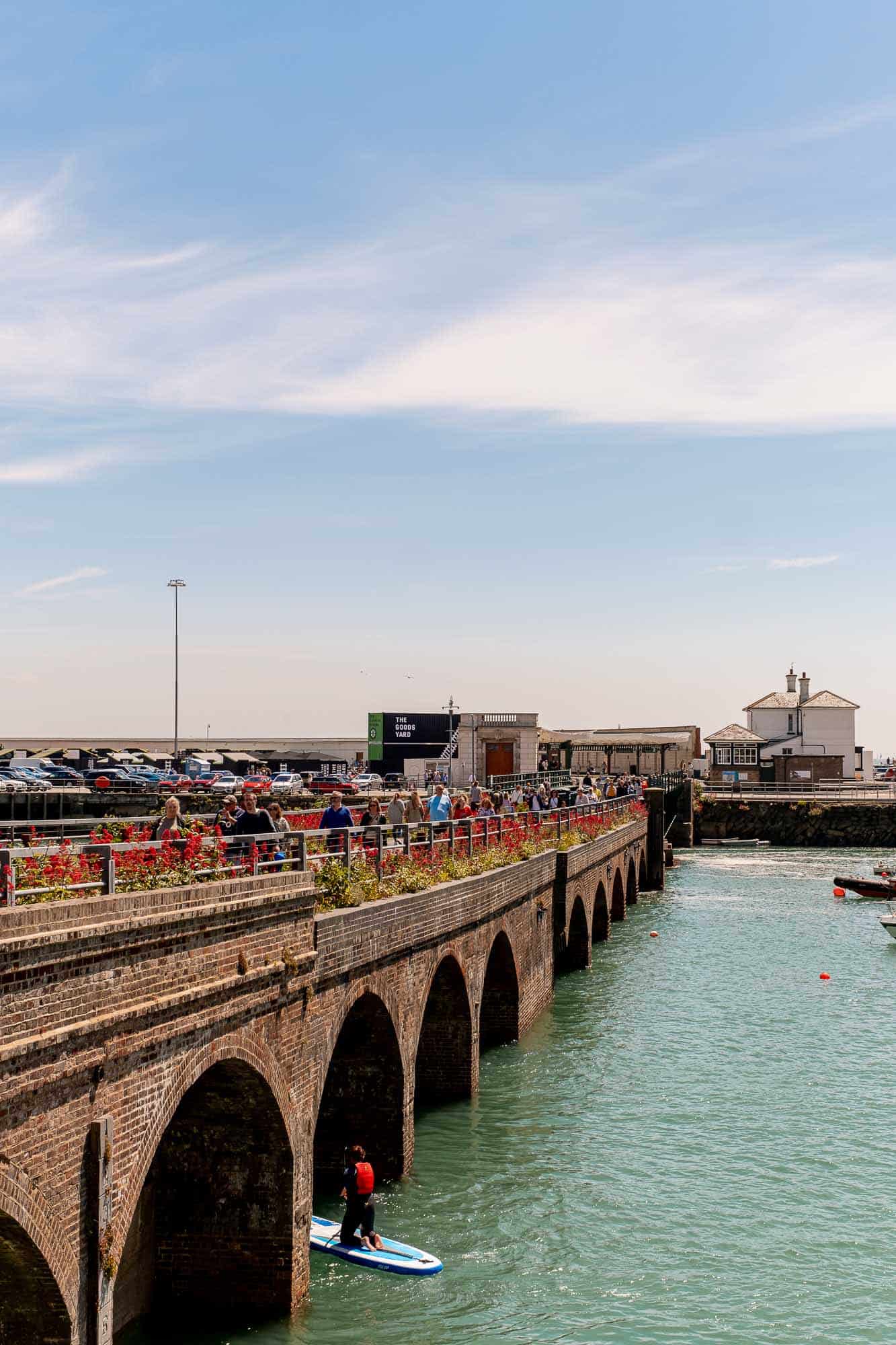
Image Quality
What really sets the Fujifilm XF 16-55mm F2.8 R LM WR apart is its excellent image quality. The optical design incorporates both extra-low dispersion and aspherical elements to reduce distortion and colour fringing, resulting in sharpness and accurate colour rendering throughout the zoom range.
- Type: Standard Zoom lens
- Best for: Travel photography
- Focal length: 16 – 55mm
- Aperture: f/2.8 – f/22
- Image stabilisation: No
- Built-in autofocus: Yes
- Weather sealing: Yes
FUJIFILM XF 10-24mm f/4 R OIS WR Lens – Best Fuji Lens For Landscape

- Excellent built quality
- Optical Image Stabilisation
- Weather resistant
- Excellent image quality with reduced distortion and improved sharpness
- Quiet autofocus performance for video
- Poor Manual Focus
- Poor ring design
- More expensive compared to other options in Fujifilm’s XF lens lineup.
The Fujifilm XF 10-24mm lens is a versatile zoom that can lend itself to a wide range of different subjects, particularly travel and landscape photography.
This XF10-24mm lens is weather-resistant, so you can shoot in adverse weather conditions. It also includes a more advanced Optical Image Stabilisation (OIS) system to help avoid unwanted camera blur in your images.
Design changes include an auto-position lock on the aperture ring to help prevent accidental aperture changes, and the body also weighs less at just 385g, so you can travel lightly.
Wide-angle 15-36mm equivalent focal length The XF10-24mmF4 R OIS WR offers a 35mm equivalent focal length of 15-36mm and a constant aperture of F4 regardless of where it is in the zoom range.
This Fujifilm lens has improved optical image stabilisation (OIS). A new and improved gyro sensor inside the XF10-24mmF4 creates an additional stop of stabilisation, bringing overall OIS performance to 3.5 stops.
This can be further extended to 6.5 stops when paired with the in-body image stabilisation (IBIS) in some X Series cameras.
The result is a whole new world of tripod-free opportunity, even after the sun goes down Advanced internal focusing system by utilising an advanced internal focusing system, the XF10-24mmF4 is capable of precision autofocus that is not just extremely fast but near-silent.
Weather-resistance against dust, moisture, and cold down to -10° In addition to its tough, metal external casing, the XF10-24mm F4 Fujifilm lens has been equipped with weather resistance that helps protect it from dust and moisture.
The lens can also operate in temperatures as low as -10°C, making it the ideal companion when battling the elements to get the perfect shot, from wild Arctic expanses to arid desert dunes.
Image Quality
As for image quality, this lens offers excellent sharpness throughout its zoom range and produces minimal distortion.
The lens handles chromatic aberration well, producing clear and vibrant images with true-to-life colours. Additionally, the aperture at f/4 allows for a nice depth of field to create a beautiful background blur (bokeh).
- Type: Wide-Angle Zoom
- Best for: Landscape photography
- Focal length: 10 – 24mm
- Aperture: f/4 – f/22
- Image stabilisation: Yes
- Built-in autofocus: Yes
- Weather sealing: Yes
Fujifilm XF 16-80mm f4 R OIS WR Lens – Most Versatile Lens

- Versatile Focal Length
- Lightweight and compact design
- Optical Image Stabilisation
- Affordable
- Autofocus hunting in low light conditions
- Maximum aperture of f/4 not suitable for night
- Zoom creep
The Fujifilm 16-80mm lens is a great choice for anyone looking for a versatile and compact zoom lens. The Fuji XF16-80mm F4 R OIS WR lens consists of 16 elements in 12 groups, and one aspherical element is specially designed to minimise field curvature and spherical aberration.
This compact and versatile lens for any shooting situation also covers an effective focal range from 24mm to 120mm (wide angle lens to mid-telephoto ) and weighs just 15. 5 oz. (440 g).
The Fujifilm 16-80mm lens also features 6.0 stops of optical image stabilisation to shoot in a wide variety of situations. The autofocus on this lens is also quick and near-silent, making it ideal for street photography.
The Fujifilm 16-80mm lens stands out as one of the best zoom lenses in Fujifilm’s lineup thanks to its compact size, wide focal range, and impressive image stabilisation capabilities.
This lens also has weather sealing in ten places along the barrel, making it a durable and reliable option for any type of shooting situation.
Image Quality
Overall, the image quality from the Fujifilm 16-80mm lens is sharp and clear thanks to its use of aspherical elements and optical image stabilisation. The autofocus is also quick and quiet, making it easy to capture fast-moving subjects.
- Type: Standard Zoom
- Best for: Travel photography
- Focal length: 10 – 24mm
- Aperture: f/4 – f/22
- Image stabilisation: Yes
- Built-in autofocus: Yes
- Weather sealing: Yes
Fujifilm 18-55mm f/2.8 – 4 – Best Kit Travel Lens

- Solid build quality
- Brighter aperture than most kit lenses
- Sharp images
- Compact and lightweight
- Image Stabilisation
- Not weather sealed
- No number markings on the aperture ring
My all-around top pick for the best Fujifilm travel lens is the Fujifilm 18-55 f/2.8. It’s a Fuji kit lens (but this is not your average kit lens) that’s compact and versatile, with a much brighter aperture than you’d usually find on a kit lens.
Weighing in at 308g, this lens is reasonably lightweight for a zoom lens. It’s compact, with an impressive build quality that feels robust. The zoom and focus rings are wonderfully smooth and heavy.
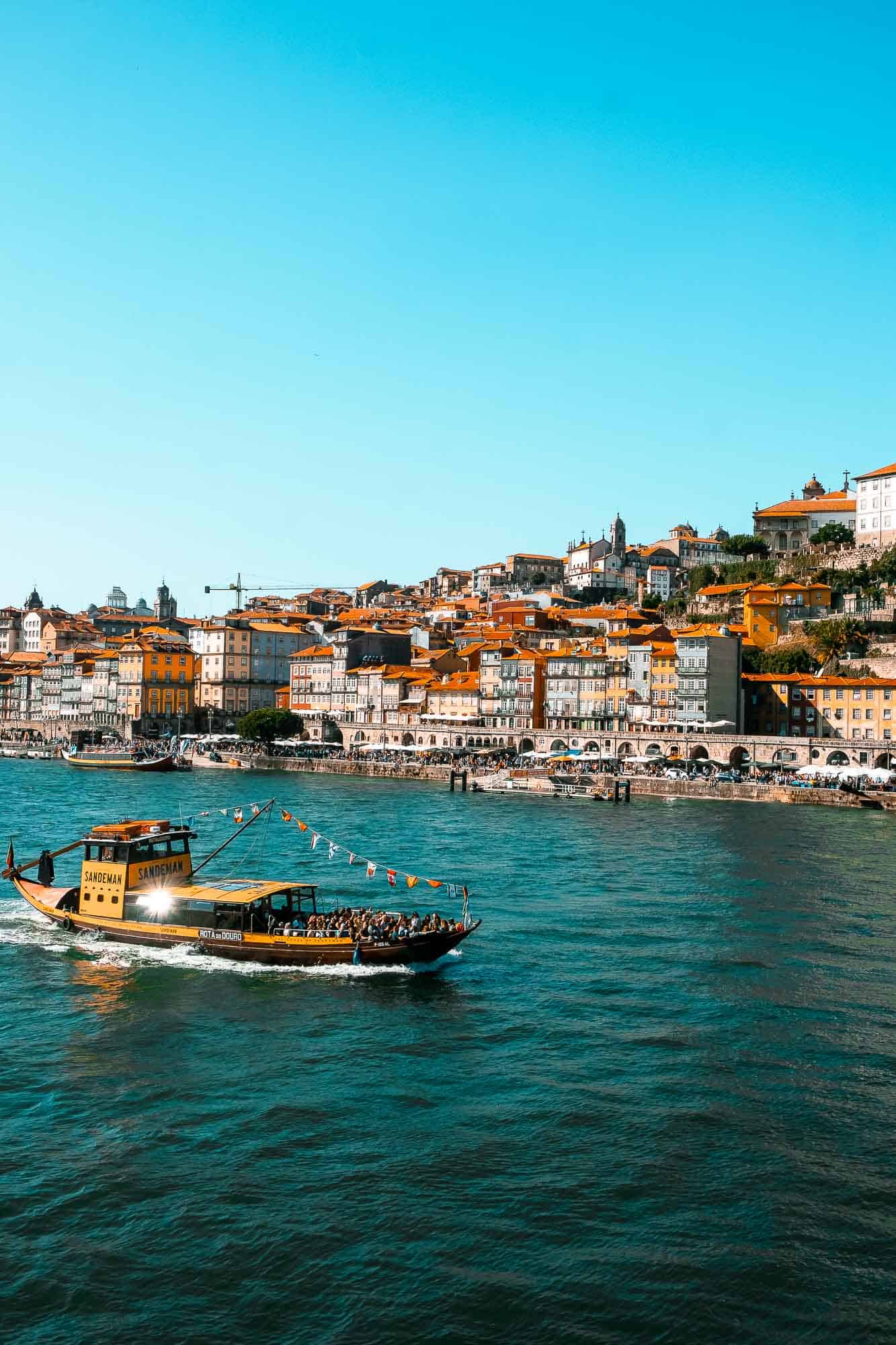
While it’s expensive for a kit lens, this is really affordable for its performance, at around £499. It’s constructed with 14 elements in 10 groups. This includes 1 extra-low dispersion element and 3 aspherical elements.
The lack of weather sealing won’t be a big issue for most casual photographers, but it’s worth considering. Not being able to shoot in strong winds and rain can limit opportunities.
Image Quality
This lens offers impressive sharpness for a relatively affordable zoom lens. Though sharpness can be lost a little around the edges in certain situations.
The relatively wide aperture allows for more out-of-focus backgrounds than most kit lenses. And the bokeh is pretty smooth.
As a fairly standard zoom lens, it can handle a variety of photography styles, from landscape shots to portraits. All in all, it’s a great all-rounder that offers impressive versatility and excellent performance for the price tag.
This lens is also great if you want to dabble in the video has optical image stabilisation and covers a focal length range from 27mm*1 wide-angle to 84mm*1 telephoto (equivalent focal length on full-frame).
Already made up your mind? Get this lens here
- Type: Standard Zoom
- Best for: All-round use for beginners
- Focal length: 18 – 55mm
- Aperture: f/2.8 – f/22
- Image stabilisation: Yes
- Built-in autofocus: Yes
- Weather sealing: No
Best Fuji Prime Lenses | Fujifilm X Mount Fuji Lens Review
Best Fujifilm’s prime lenses for travel are the: I review each of these in more depth in the following section.
Fujifilm 23mm f/2 WR – Best Lens For Street Photogrpahy
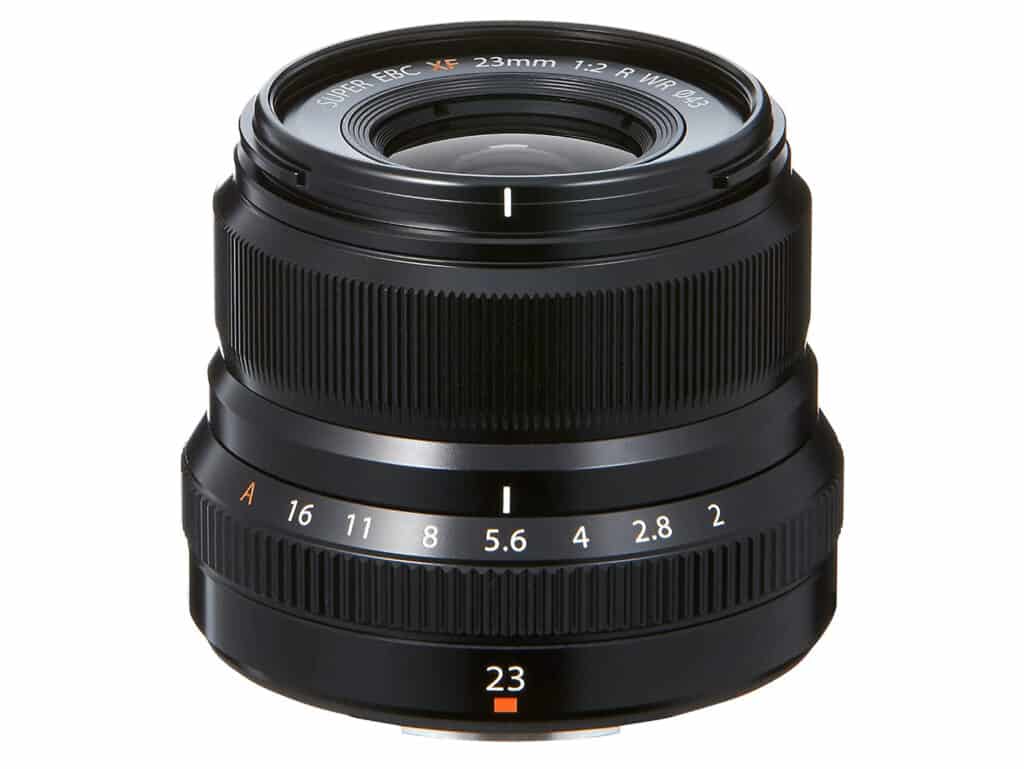
- Fairly large maximum aperture
- Good value
- Compact and lightweight
- Quick, silent autofocus
- Weather and dust resistant
- No image stabilisation
- Not ideal for close-up shots
- Bokeh could be better
- Image sharpness fades at the corners
Fujifilm’s 23mm f/2 WR is a high-quality, relatively affordable lens that offers great value for money. It’s a Fuji wide-angle lens best suited to street and travel photography. This is one of the best Fuji prime lenses for travel.
At just 181g, this lens is relatively small and light when compared to other Fujinon lenses, which are ideal for on-the-go travel photography.
Considering this small stature, the 23mm f/2 is particularly comfortable with smaller cameras. With a build that is simple, sturdy, and fuss-free.
The included lens hood and cap are plastic rather than metal, but that’s hardly a deal-breaker.

It’s also weather and dust-resistant, unlike the other lenses on this list. So you can get good use out of it even when the sun stops shining or you head out on a more rugged adventure.
The autofocus is fast and silent, both big wins in travel photography. A downfall here, though, is that there’s no switch on the lens for manual focus, so you have to change to manual docs on your camera if you wish to do so.
This lens is available for a relatively affordable price. Which, paired with its high quality, makes it a great value buy. It costs around £429 and is more affordable than many other Fuji lenses. Just bear in mind that it doesn’t have onboard image stabilisation.
The lens configuration includes 10 elements in 6 groups, with 2 aspherical elements. You can read my in-depth review of the Fujifilm 23mm 2f lens.
Image Quality
The image’s sharpness is brilliant in the centre, but it fades slightly toward the corners. This may be a slight issue for some serious photographers, but it’s unlikely to affect most travellers.
You’ll find good sharpness if you play around with the f-stop (shooting between f5 – f8). And the lens offers simple, good-looking bokeh.

Considering its short focal length, this lens is best for landscape, travel and street photography. It’s good at capturing wide scenes rather than close-up subjects and full-body-person shots.
So, I wouldn’t recommend it if you enjoy taking portraits, as the wide-angle lenses tend to distort facial features.
- Type: Wide-Angle Prime
- Best for: Street photography
- Focal length: 23mm
- Aperture: f/2 – f/16
- Image stabilisation: No
- Built-in autofocus: Yes
- Weather sealing: Yes
Already made up your mind? Get this lens here
Fujifilm XF27mm F2.8 R WR lens – Best Everyday Use Lens

- Compact and lightweight
- Weather resistant
- Fast autofocus
- Wide F2.8 aperture
- Affordable price
- Produces sharp images with beautiful bokeh
- No image stabilisation
- Focusing not super fast
- Not great close focus
The FUJINON XF27mmF2.8 R WR is a compact, ‘pancake-style’ lens. Weighing just 84g, it is designed to offer maximum portability without any loss of image quality.
Its natural field of view closely resembles what the human eye sees, making it great for everyday use.
However, it comes into its own when creating travel and documentary images or everyday use that exude the true essence of a location or area.
The 41mm equivalent focal length of the XF 27mm pancake lens closely resembles the field of view seen by the human eye, making it suitable for various subjects, such as portraits and nature photography.
This lens also offers weather resistance, so the elements can’t hold you back, and it features an aperture ring to change the settings easier.
The lens has an aperture ring to change the settings easier and weather-resistant construction.
As one of Fujifilm’s premium prime lenses, the XF 27mm offers excellent image quality in a compact design. Its versatility and portability make it a great choice for travel photographers.
This lens is weather-resistant and capable of operating in temperatures as low as 14°F (-10°C), making it the perfect companion for shooting in all conditions.
Image Quality
Regarding image quality, the Fujifilm XF27mm F2.8 R WR does not disappoint. The colours are vibrant and true to life, with excellent sharpness in both the centre and corners of the frame.
Its advanced optical design minimises aberrations and distortions for a high level of image quality.
This lens also produces beautiful bokeh, making it an excellent choice for portraits or close-up shots. Overall, this lens delivers professional-level results at a fraction of the cost.
- Type: Standard Prime
- Best for: Everyday use
- Focal length: 27mm
- Aperture: f/2.8
- Image stabilisation: Yes
- Built-in autofocus: Yes
- Weather sealing: Yes
Fujifilm 35mm f/1.4

- Very wide maximum aperture
- Brilliant image quality
- Top-notch build quality
- Lightweight and compact
- Versatile focal length
- Great for low light photography
- Not weather resistant
- No image stabilisation
- The aperture ring can feel a little loose
Fujifilm’s 35mm f/1.4 offers outstanding image and build quality in a compact package. And all for a very reasonable price.
It’s a perfect everyday lens, ideal for various photography styles. I think it’s one of the best travel lenses on the market.
The Fuji 35mm f/1.4 is an all-metal barrel with an exceptionally high build quality. The mount and hood are both metal as well. And the lens is light and compact, weighing only 187g.

You’ll find a focus ring and an aperture ring on the barrel, both of which are pretty smooth and precise. Although the aperture ring can sometimes feel like it doesn’t have quite enough resistance.
The autofocus is quick and highly accurate. Though it does make a bit of a ‘chattering’ sound if you listen closely.
It’s constructed with 8 elements in 6 groups, including 1 aspherical element. You can read my in-depth review of the Fujifilm 35mm f1.4 lens.
At £499, it’s a little pricier than the previous option. But the wide aperture, brilliant image quality, and greater versatility make it worth spending on.
Image Quality
The sharpness of this lens is hard to fault. Images are sharp at the centre, with sharpness loss in the corners at larger apertures. But it’s a particularly sharp lens on the whole.
Bokeh is smooth and gorgeous with slightly duller light sources. But it isn’t quite as pleasing if the light source is too bright.
This lens is a great all-rounder with a 35mm focal length (which translates to about 53mm on Fuji’s APS-C sensors). It’s a jack of all trades and a master of some, including street photography and portraits.
Already made up your mind? Get this lens here
- Type: Prime lens
- Best for: General use / Street photography
- Focal length: 35mm
- Aperture: f/1.4 – f/16
- Image stabilisation: No
- Built-in autofocus: Yes
- Weather sealing: No
Fujifilm 56mm f/1.2 – Best Lens For Portraits

- Outstanding image quality
- Sturdy build
- Very wide maximum aperture
- Stunning bokeh
- Great for low light photography
- Quite expensive
- No onboard stabilisation
- Not weather sealed
- Focus ring could have more tension
The Fuji XF 56mm f/1.2 is a top-quality portrait and shallow depth of field lens. With its extremely wide aperture (f/1.2), this thing can capture stunning images with creamy, out-of-focus backgrounds.
At 405g, this lens is a bit heavier and bulkier than the other lenses on this list. But it’s still by no means excessive in size and will be a comfortable travel companion.
There is a focus ring and an aperture ring with tactile clicks on the barrel. In my opinion, the aperture ring could do with a bit more resistance.
But the focus ring is very comfortable to use. It boasts a top-quality, almost entirely metal constriction and feels solid in the hand.
Just like the 35mm lens above, this model’s autofocus motor makes a bit of a whirring noise when in use. But it isn’t too loud. The lens is constructed with 11 elements in 8 groups – 1 aspherical and 2 extra-low dispersion.

It is the priciest of the bunch discussed in this post, at around £849. But you’re paying for some seriously high-quality glass.
Image Quality
The sharpness is exceptional in the centre and around the edges and corners. It’s even sharp when wide open. And with its ultra-fast aperture, the bokeh is breathtakingly creamy.
The autofocus system works pretty quickly and accurately, even in low-light conditions. There is a nice focus ring on the barrel; some say the lens isn’t terribly responsive in manual focus mode.
But this is not the case for me, this lens requires a lot more knowledge of photography, but it is a beauty to show.

With its extremely wide maximum aperture and 56mm focal length (About 85mm full-frame equivalent), this lens is ideal for portrait photography. But it works brilliantly for any shots where you want the subject to stand out against the background.
Already made up your mind? Get this lens here
- Type: Prime lens
- Best for: Portraits / shallow depth of field (I also use this for travel)
- Focal length: 56mm
- Aperture: f/1.2 – f/16
- Image stabilisation: No
- Built-in autofocus: Yes
- Weather sealing: No
Fujifilm XF 16mm f1.4 R WR Lens – Best Lens For Architecture

- Wide field of view
- Fast F1.4 aperture
- Weather-resistant construction
- Sharp image quality with Nano GI coating
- Fast focusing
- Expensive compared to other lenses
- Some chromatic aberration at wide apertures
- Some vignetting at wide apertures
The Fujifilm 16mm lens is a wide-angle prime lens that is weather-resistant and offers a fast maximum aperture of F1.4.
This lens is perfect for capturing dramatic landscapes and beautiful architecture, while it’s Nano GI coating ensures that images are sharp with improved definition.
The focusing ring on the XF16mmF1.4 R WR slides backward and forwards to enable users to quickly switch between manual and autofocus, and the lens also features a total of nine seals that prevent water and dust from getting into the body.
One of the standout features of the Fujifilm 16mm lens is its wide field of view, allowing for more versatility in capturing a scene.
The fast F1.4 aperture also allows for blurrier backgrounds and the ability to shoot in low-lighting conditions without a camera shake. Additionally, this lens has a great close-up capability, with a minimum focus distance of 15cm.
The weather-resistant design allows photographers to continue shooting even in damp or sub-zero conditions, making it one of Fujifilm’s best prime lenses for travel photography.
Image Quality
The Fujifilm 16mm lens is a wide-angle lens that offers excellent image quality and features weather-resistant construction for shooting in difficult conditions.
This lens is perfect for capturing dramatic landscapes and beautiful architecture, while its fast maximum aperture of F1.4 allows for blurrier backgrounds and the ability to shoot in low lighting conditions without a camera shake.
What to Look for in a Travel Lens
Before we get into the recommendations and reviews, I’d like to offer a quick breakdown of what you should look for in the best Fuji travel lenses. The key elements are portability, versatility, quality, and price.
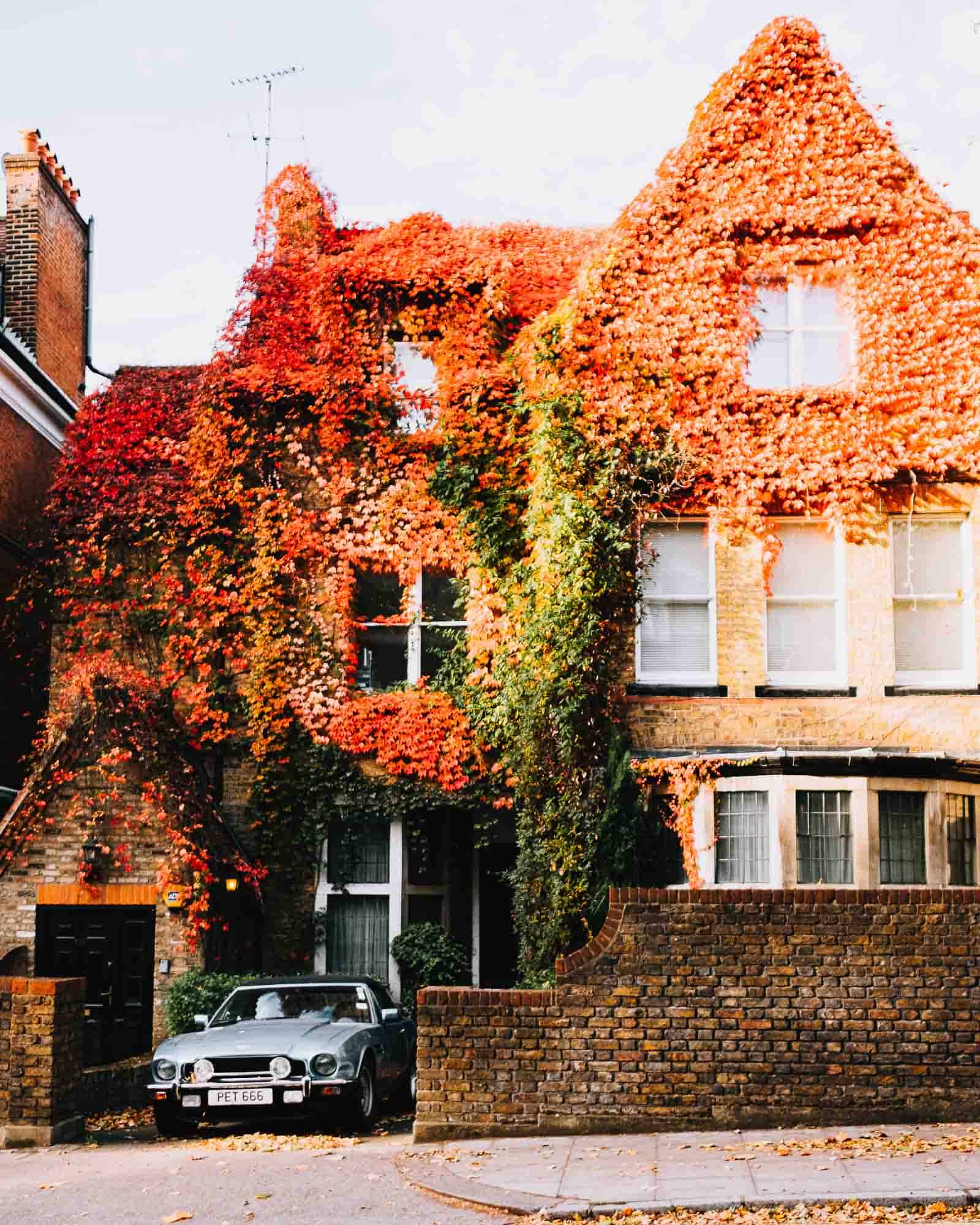
While you won’t be able to find a lens that ticks all of these boxes, they’re all important considerations, and you’ll be able to decide which are most important for your purposes. So let’s get into it.
Portability
This one’s a bit of a no-brainer. You don’t want to be lugging around bulky gear cases or enormous telephoto lenses when you’re on the move.
Doing so will weigh you down and can distract you from your travel experiences. So, it’s best to pack light when it comes to camera travel gear.
Having one good versatile lens, or a couple more specialised lenses, is ideal. I take a less-is-more approach, and you’ll thank me late.
Versatility
Travel photography often means being thrown into a variety of situations and being able to capture moments on the fly as they arise.
So you’ll want to opt for lenses that are versatile enough to perform well in this diverse range of situations.
Due to their variable focal length, zoom lenses are great for versatility. But an excellent prime lens can make the ultimate addition to your travel kit, particularly if you already have a zoom kit lens.
Quality
Obviously, the quality of the images you take will be an essential factor. And a lens is often one of the most important elements in dictating image quality.
One of the key things to look out for is the aperture (this is what controls the amount of light passing through the lens).
Aperture is signified by the ‘f’ number on a lens – the lower the number, the larger the maximum aperture. Larger aperture lenses allow more light in, meaning better low-light performance.
They also offer great flexibility and are capable of taking more professional-looking images (with out-of-focus backgrounds and foregrounds and stunning bokeh).
Of course, there are other elements that dictate quality, and I’ll get into each of them in the reviews.
Price
All I can say about the price is that you should spend what you’re comfortable spending and focus on getting great value for money. The lenses I’ve reviewed here all offer a good bang for your buck.
Now I’ll briefly discuss the different lens types and why each may be suitable for your travel needs. The two main categories are prime lenses and zoom lenses. Here’s a detailed breakdown of each one.
Why Choose a Fuji Zoom Lens for Travel
Zoom lenses have a variable focal length which, as the name suggests, allows you to zoom. A zoom ring on the lens is used to adjust the focal length, which changes the field of view. So you can switch between wide-angle and tighter shots.
All this means that zoom lenses are more versatile than their prime cousins. They can be used for a wider range of purposes and capture subjects at various distances from the camera.

Professionals tend to favour prime lenses over zoom lenses, but that’s not to say that zoom lenses are necessary for inferior quality.
In fact, some incredibly impressive zoom lenses on the market rival even the finest prime lenses. They’ve been gaining popularity as their quality standards improve over time, and their convenience continues to impress.
So is a zoom lens the right travel photography lens for you? Well, if you like to pack light and want versatility in your photography, then a zoom lens will treat you well.
And if you’re not a professional photographer, the quality is very unlikely to be an issue, even with a relatively affordable zoom lens.
Zoom lenses tend to be the more practical option for most travellers. Their diverse functionality, convenience, and ever-improving quality make them ideal for most purposes.
But prime lenses certainly deserve consideration for their exceptional quality. I’ll let you decide for yourself.
Why Choose a prime lens for Travel
Prime lenses are lenses with a single, fixed focal length. Meaning they can’t zoom in or out. But they’ve been the firm favourite of professional photographers since the beginning.
The main draw of prime lenses is the quality. While zoom lenses have been improving in recent years, prime lenses are considered for their high quality and ability to produce images of a professional standard.
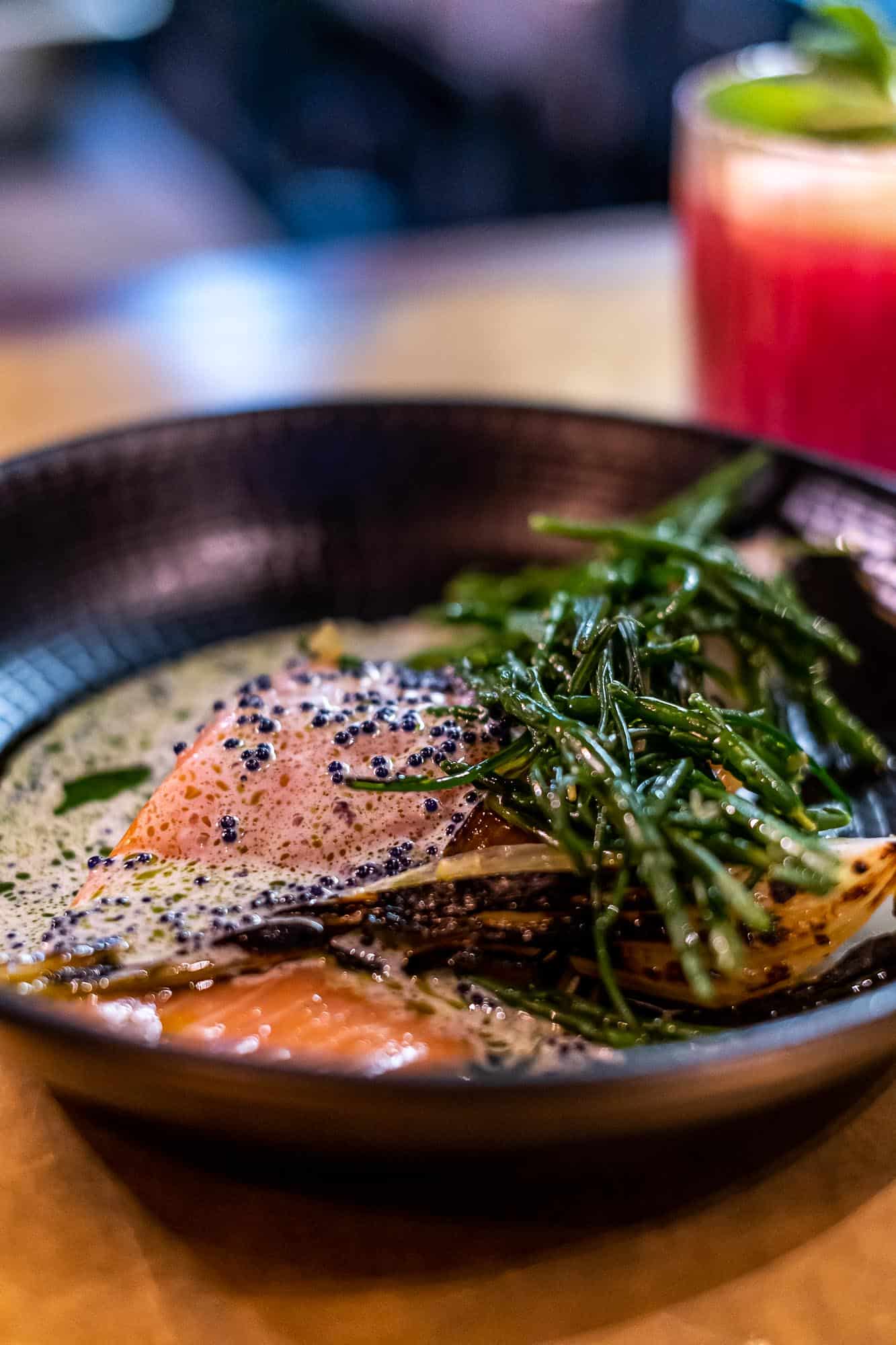
Another attractive feature of prime lenses is their relatively affordable price. It sounds counter-intuitive, I know.
But prime lenses have fewer mechanical structures and moving parts, so the cost can be kept relatively low. They also tend to be lighter and smaller than most zoom lenses for the same reason.
However, seeing as they are not versatile in terms of focal length, most photographers will have multiple prime lenses.
Each with a different focal length and serves a different function. This can mean carrying around a case full of prime lenses rather than a single zoom lens. And it means a higher cost and more weight for comparable versatility.
The last advantage of prime lenses is that they’re able to offer much wider apertures than most zoom lenses.
So are prime lenses right for travel? It’s a tough question. But at the end of the day, it depends on the type of photography you’ll be doing and how light you want to pack.
If you’re sticking to one style of photography, such as portraiture or street photography, you may only need one focal length to play with.
In this case, one quality prime lens could do the job well. But if you want to dabble in a diverse range of photography styles, carrying a case of prime lenses might be inconvenient and bulky.
You’re likely better off opting for a single, high-quality zoom lens that can be used for various styles.
If you don’t mind carrying multiple lenses and have the budget for them, having a couple of prime lenses will serve you well.
Fujifilm as a Brand
Now for a quick rundown of Fujifilm as a brand and why their cameras are great for travel. Seeing as you’re reading this post, it’s likely that you already have a Fuji camera. But for those still considering buying one, this section may come in handy.
Fujifilm has been around since 1934 but has upped their game in recent years with an influx of high-end, high-quality mirrorless cameras taking on the larger full-frame cameras.
While they were initially less performance-focused and more concerned with the design, Fujifilm cameras and lenses now rival the likes of Nikon, Sony, and Canon. They offer impressively high quality and are often on the front lines of innovation.
👉 READ MY GUIDE ON THE BEST FUJI CAMERA FOR TRAVEL
Fujifilm is also one of the strongest brands for mirrorless cameras. In fact, they’ve dropped their SLR range entirely in favour of focusing all their attention on the highest quality mirrorless options and fangirls worldwide like me rejoice.
Mirrorless cameras do away with the bulky mirror mechanisms used in DSLRs without forgoing image quality. This means that they’re lighter and more compact than DSLR cameras, and therefore better for travelling.
Best Fuji Lens for Travel: FAQs
When people ask me about the Best lens for Fujifilm when it comes to travel, here are the answers to some of the most common questions I get!
Do you take a telephoto lens when traveling?
When travelling, many photographers opt to bring along a telephoto lens. These lenses allow you to capture close-up shots of your subject without getting too close, which can be ideal in situations where you don’t want to disturb your subject or be obtrusive.
This is especially useful when photographing wildlife or other shy subjects. Telephoto lenses also compress the foreground and background of your shot, creating a more dramatic effect in your photos.
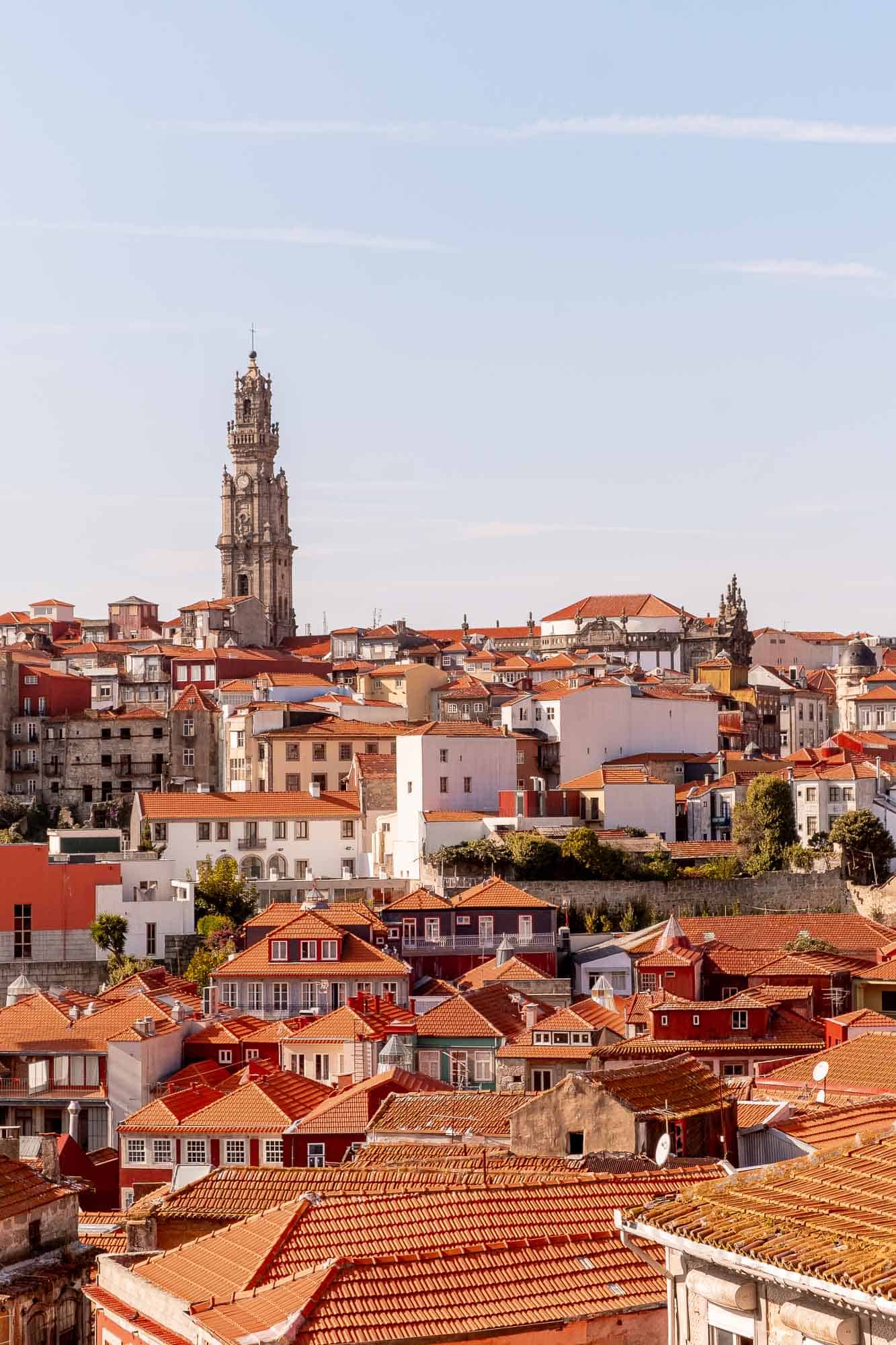
And, of course, they allow you to capture more of the scene in front of you. However, telephoto lenses can be bulky and heavy, so it’s important to consider whether the added weight is worth it for the types of photos you plan to take on your trip.
Which Fuji lens is the sharpest?
When it comes to sharpness, there is no definitive answer as to which Fuji lens is the sharpest. This is because sharpness is relative, and what one photographer considers sharp may not be as sharp as another photographer’s standards.
That said, a few lenses are generally considered to be among the sharpest available for Fuji cameras. These include the Fujinon XF 56mm f/1.2 R, Fujinon XF 16mm f/1.4 R WR, and the Fujinon XF 16-55mm f/2.8 R LM WR. All three of these lenses are designed for high-resolution cameras and offer excellent optics and construction.
As a result, they are all capable of producing exceptionally sharp images. So, if you’re looking for a lens that can give you the best possible results in terms of sharpness, then any of these three would be a great option.
Best Fuji lens for family travel?
When travelling with family, you want a Fuji lens that can capture both wide landscapes and intimate moments. The Fujinon XF16-55mm f/2.8 R LM WR OIS is a great all-purpose lens that offers a versatile zoom range, is weather-resistant, and has image stabilisation for clear photos and videos. Making it ideal for capturing both sweeping landscapes and intimate close-ups.
If you’re looking for something with a little more reach, the Fujinon XF55-200mm f/3.5-4.8 R LM OIS is an excellent option for capturing distant subjects without sacrificing quality.
Whichever Fuji lens you choose, you’ll surely capture beautiful memories of your family travels.
Fujifilm X-T4 best lenses for video
If you’re a Fujifilm photographer looking to get the best lenses for video, the Fujifilm X-T4 is a great option. Its flip-out screen and 4K 60p recording make it an excellent choice for anyone looking to get the most out of their video footage.
But what are the best lenses for Fujifilm X-T4? Here are our top picks of the best Fuji lenses:
- Fujifilm XF 16-55mm f/2.8 R LM WR Lens: This all-purpose zoom lens is great for everything from landscapes to portraits. With a fast maximum aperture of f/2.8, it’s perfect for low-light shooting and video recording.
- Fujifilm XF 50-140mm f/2.8 R LM OIS WR Lens: This telephoto zoom lens is perfect for capturing detailed close-ups and long-distance shots. With optical image stabilisation and a fast maximum aperture of f/2.8, it’s ideal for video recording and low-light shooting.
- Fujifilm XF 18-55mm f/2.8-4 R LM OIS Lens: This standard zoom is a great all-purpose option for photographers and videographers alike. With optical image stabilisation and a fast maximum aperture of f/2.8, it’s arguably the best Fuji lens for low light shooting or capturing smooth video footage.
- Fujifilm XF 23mm f/1.4 R Lens: This fast prime lens is perfect for low-light shooting and shallow depth-of-field effects. With a maximum aperture of f/1.4, it’s one of the fastest wide-angle lenses available for the Fujifilm X system.
- Fujifilm XF 35mm f/1.4 R Lens: Another fast prime lens, the Fujifilm XF 35mm f/1.4 R, is perfect for general-purpose photography and videography alike. With a maximum aperture of f/1.4, it can capture stunning images and videos in low light or with shallower depth-of-field effects than slower lenses can achieve. These are some of the best Fuji camera lenses for video.
Best Fujifilm Lens for Travel: Wrapping Up
So, there you have it – the best Fujifilm lenses for travel. I made sure to review a range of options here that will cover most travel photographers’ needs.
I’m sure one (or more) of these fantastic lenses will be right for you, whether you’re looking for the best budget Fujifilm lenses, the best lenses for Fuji XT2, or just the overall best travel photography lens offered by Fujifilm.
I have all 9 lenses on this list (as I said, I’m a Fuji fangirl), and I’ve even reviewed them on my Youtube channel.
All of these Fuji lenses for travel are a great step up from most standard kit lenses, and they’re sure to help you push your photography to the next level. So, grab your new Fuji lens, get out there, and go take some incredible pictures.
Read More Fuji Lenses Review
📸 Fuji 23mm vs 35mm Lens
Fuji 23mm vs. 35mm Lens Showdown: Which One Deserves a Spot in Your Camera Bag? We delve into the strengths of each lens, helping you decide the perfect match for your photography needs!
📸 Best Fuji Prime Lens For Travel
Unlocking the Magic of Fuji’s Prime Lenses: Your Guide to the Best Picks and How They Transform Your Photography. Discover the ideal Fuji prime lens that aligns with your style and elevates your images.
📸 Best Fujifilm Lens for Street Photography
Mastering the Urban Canvas: The Best Fuji Lens for Street Photography and Why It’s a Must-Have. Dive into our top picks that can capture the soul of the city with every shot.
📸 9 Best Fuji Lenses for Portraits
The Best Fuji Lenses for Stunning Portraits and Why You Need One. Explore our top picks that can elevate your portrait photography to new heights.
📸 Fuji 16-55mm vs 18-55mm Lens
The Best Fuji Fuji Zoom Lens For Travel Showdown: 16-55mm vs. 18-55mm – Which One Fits Your Photography Journey? We analyze the strengths of each lens, helping you make an informed decision for your photography ventures.

One Comment